Welcome to the adventure of a lifetime! The Tateyama Kurobe Alpine Route isn’t just another train ride or bus journey; it’s an epic cross-mountain traverse that takes you straight into the heart of Japan’s most dramatic landscapes. Often called the “Roof of Japan”, this legendary route runs right across the mighty Japanese Alps. Picture soaring peaks clad in mist, narrow valleys that plunge deep into the earth, and crystal-clear streams winding through forests dyed in seasonal hues.
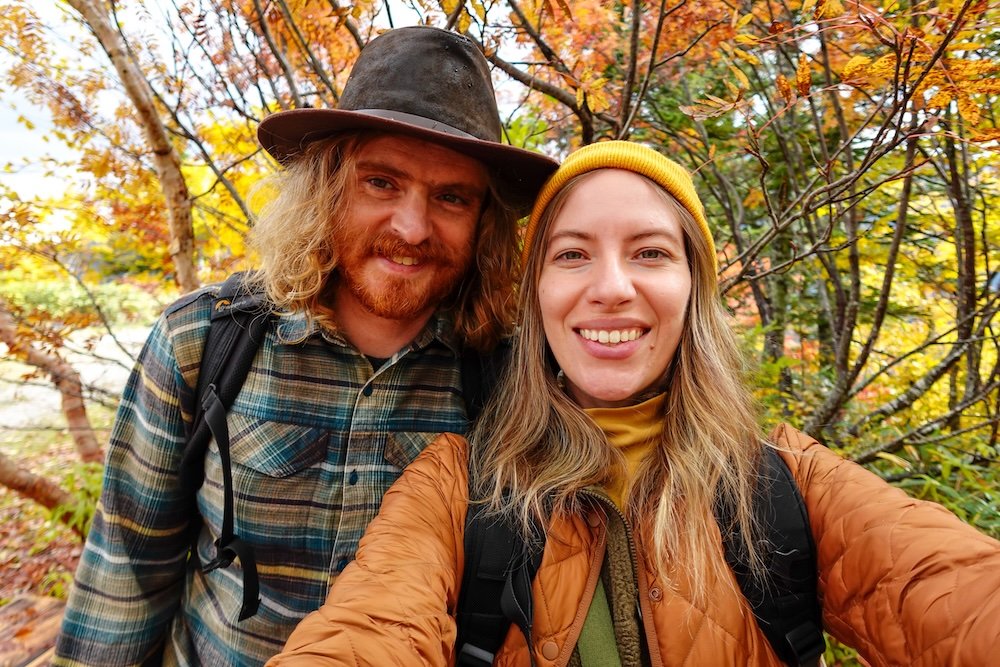
Overview of the Tateyama Kurobe Alpine Route
Over the course of the day, you’ll experience a breathtaking elevation change of over 2,400 meters. It’s more than just a stat—this immense shift means you’ll start in the lowlands and climb all the way up through evergreen forests, fiery autumn woodlands, and eventually into regions that feel like high alpine tundra. You won’t get bored here. You’ll hop between multiple modes of transportation, including scenic trains, snaking bus routes, aerial ropeways that make you feel like you’re floating, sturdy cable cars, and even a few good old-fashioned walking trails. All of these transitions weave together to create a well-orchestrated journey like no other.
source: Samuel and Audrey YouTube Channel: Nomadic Samuel + That Backpacker as hosts
Experiencing Autumn in Japan
If you’re lucky enough to tackle this route in the fall, prepare to have your senses dazzled. Autumn in Japan is a season like no other—vibrant reds, oranges, and yellows blaze across the mountainsides, turning entire forests into works of living art. One moment, you’re surrounded by deep emerald greens and gentle breezes, and the next you’re drifting through corridors of blazing maple leaves.
It’s not just about the colors, either. The entire landscape shifts character as you ascend. Within a single day, you might start feeling the mild warmth of an autumn morning and end up needing to zip your jacket against a crisp alpine chill by afternoon. This natural progression through the seasons, compressed into a matter of hours, keeps every second engaging and every stop along the route fresh. You’re not just observing nature—you’re experiencing it firsthand, peeling back the layers of scenery as you climb higher and higher.
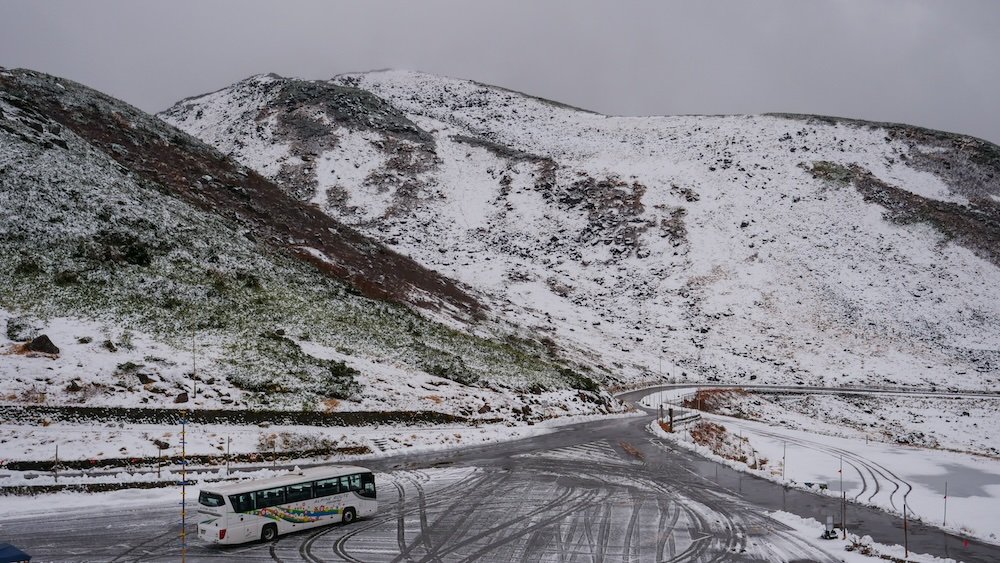
Why Take This Journey?
You might be wondering: with so many scenic routes in Japan, what makes this particular adventure worth your time? The short answer: it’s epic. The long answer involves a mix of awe-inspiring sights, cultural curiosities, and convenient travel connections that seamlessly fit into a broader travel itinerary.
For starters, the epic panoramas of Japan’s alpine beauty along the Tateyama Kurobe Alpine Route will leave even the most seasoned travelers speechless. We’re talking peaks that pierce through cloud banks, lakes that shimmer under the autumn sun, and forest floors carpeted in a kaleidoscope of leaves. Every twist in the route offers a new vantage point, each more jaw-dropping than the last.
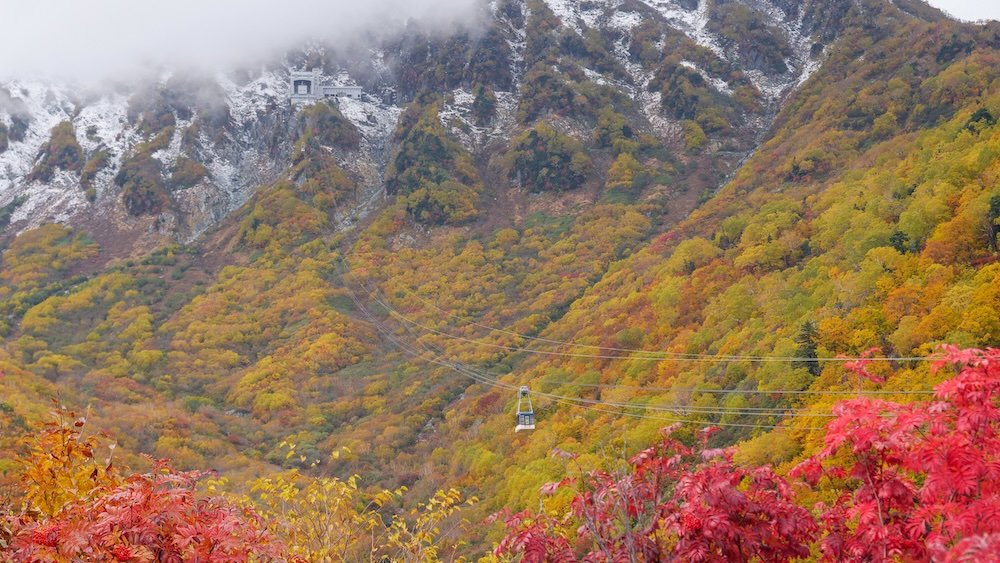
But it’s not just nature showing off. There’s a deep historical and cultural undercurrent here. Take the Kurobe Dam, for instance. This monumental feat of engineering, built between 1956 and 1963, symbolizes Japan’s post-war resilience and determination. Today, it stands as the tallest dam in the country and a proud reminder of what can be achieved when human ingenuity meets Mother Nature’s challenges. Walking across its impressive length while gazing out at the mountainous terrain is a humbling experience that effortlessly blends the old and the new, the natural and the man-made.
Easy onward connections to Toyama or Nagano at the end of your journey are the cherry on top. Unlike some remote escapades that leave you stranded in the middle of nowhere, this route is user-friendly. Whether you’re a seasoned backpacker who thrives on independent adventures or a first-time visitor looking for a curated day trip that connects easily to other major destinations, the Tateyama Kurobe Alpine Route fits snugly into your travel plans. From here, you can explore bustling cityscapes, sample world-class sushi, or continue your mountain adventures elsewhere.
In short:
- Epic Scenery: Check!
- Cultural & Historical Insights: Absolutely.
- Convenient Travel Connections: You got it.
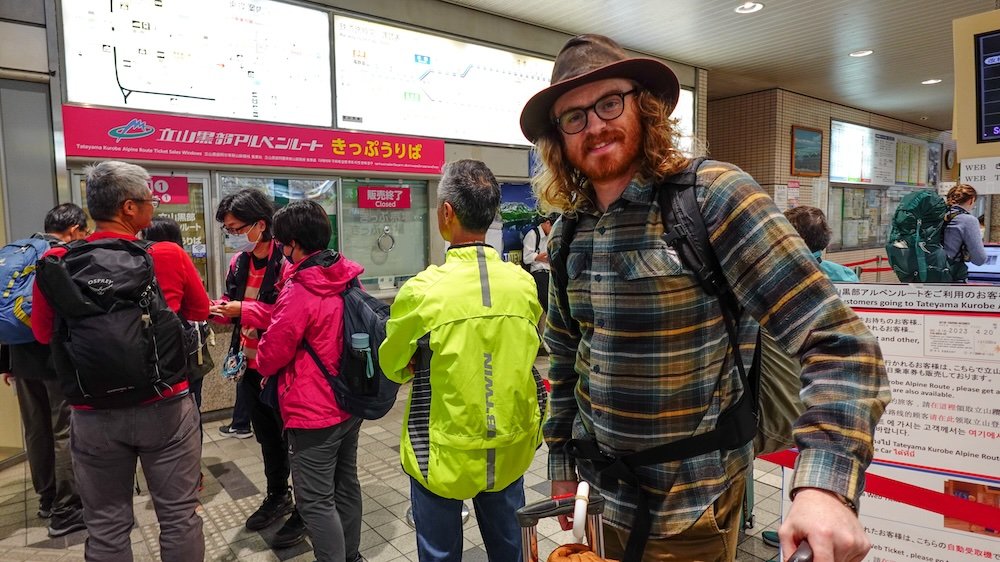
Practical Planning Before You Go
Embarking on the Tateyama Kurobe Alpine Route is more than just showing up and hopping on a train. A smooth, enjoyable journey often comes down to smart preparation—knowing where to start, what time of year to visit, how to handle tickets, and what to do with your bags. Let’s dive into the practical details that will help you make the most of this unforgettable experience.
Starting Points: Toyama vs. Nagano
Deciding Your Direction of Travel
You’ve got two main gateways for tackling the Alpine Route: Toyama on the west and Nagano on the east. Which one should you choose? It depends on your travel plans before and after the journey.
- Starting from Toyama: Ideal if you’re coming from or heading towards the Sea of Japan coast. Toyama offers great seafood, easy train connections, and a more gradual climb up into the Alps.
- Starting from Nagano: Perfect if you’re continuing on to central Japan or arriving from Tokyo. Nagano is well-known for its temples (like Zenko-ji) and its proximity to the Japanese Alps, making it a natural launching pad for your mountain adventure.
Accessibility & Transportation Links
Both Toyama and Nagano boast excellent public transportation links, with Shinkansen (bullet train) services connecting them to major cities. Toyama’s Dentetsu Station makes ticket buying for the Alpine Route a breeze. In Nagano, buses to the starting point are straightforward and well-marked.
- Tip: Consider where you’ll be after the route. If you plan to head back to Tokyo, starting in Toyama and ending in Nagano might save you time and money.
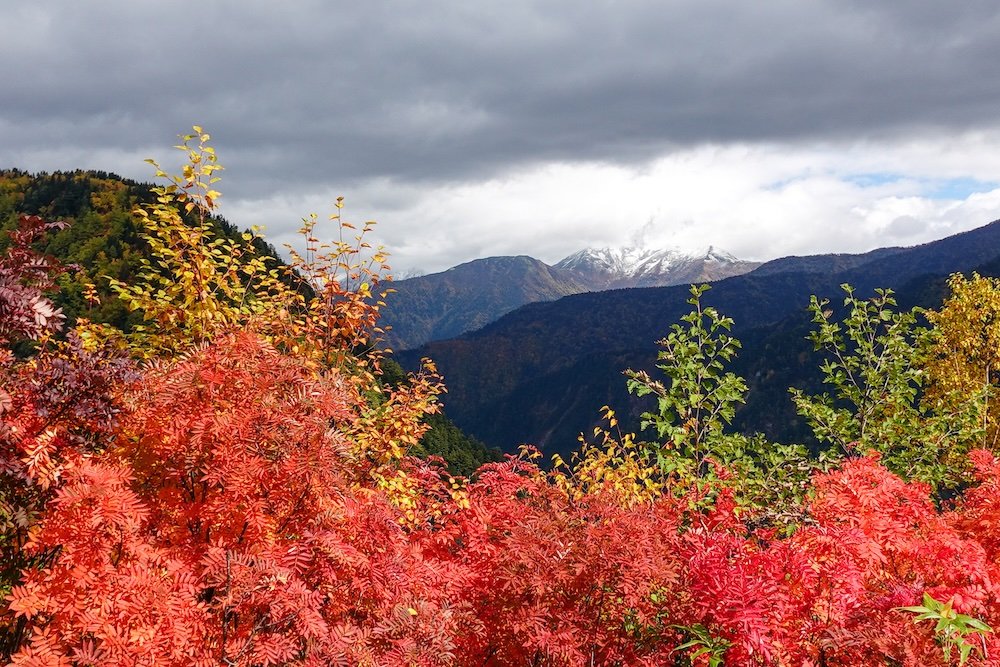
Best Time to Visit
Peak Autumn Colors
The Alpine Route is open from spring to autumn, but let’s be honest, autumn steals the show. Aim for late September to mid-October to witness those radiant reds, oranges, and yellows carpeting the mountain slopes. During this window, the scenery is at its most dramatic—forests aflame with color and mountain peaks dusted with early snow make for incredible photos.
Weather Considerations & Layering Up
Weather in the Alps is famously fickle. Morning sunshine might give way to afternoon chills, especially as you climb higher. Be prepared:
- Layer Your Clothing: Start with a breathable base layer, add a warm fleece or sweater, and bring a waterproof jacket.
- Footwear: Comfortable, sturdy shoes are a must. Some sections might be a bit slippery after rain, and you’ll want good traction.
- Accessories: A light scarf, gloves, and a hat can make all the difference when those alpine breezes pick up.
Tip: Check weather forecasts a day or two in advance. If you have flexibility, pick the sunniest day for the best views.
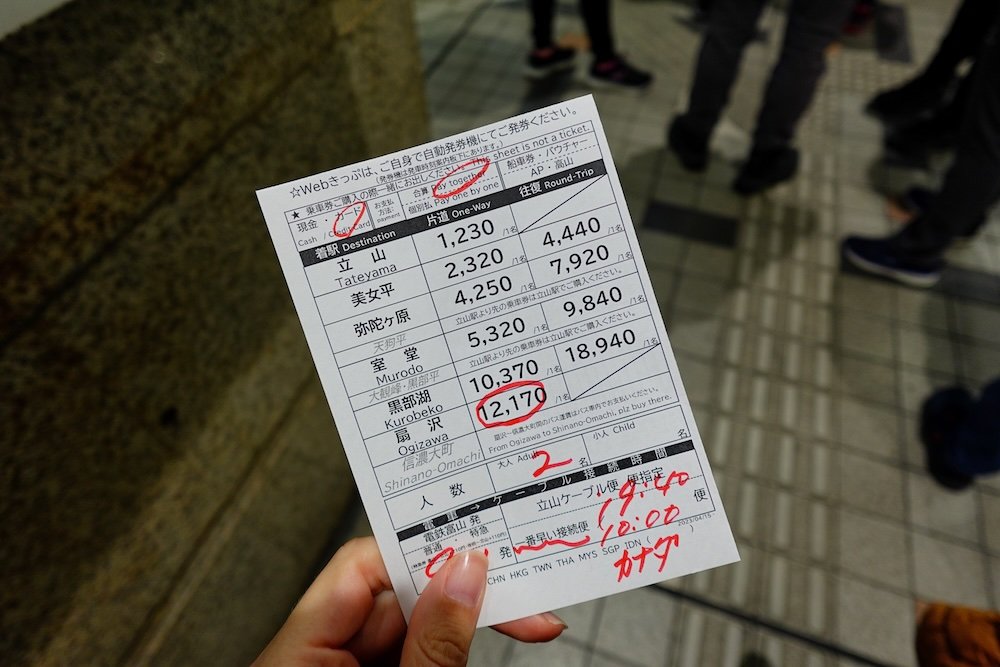
Tickets and Costs
Purchasing Alpine Route Tickets
You can buy your official “Alpine Route” tickets at Dentetsu Toyama Station, where English-speaking staff can guide you through the process. Having a single, combined ticket simplifies the trip—no fumbling around for change at every stop, and no confusion about which mode of transportation is next.
Pass Options & Discounts
There are various passes available, some bundling train journeys to and from major cities like Tokyo or Kyoto.
- Alpine-Takayama-Matsumoto Area Tourist Pass: Perfect if you’re exploring beyond the route itself.
- Japan Rail Pass Holders: While the Alpine Route isn’t fully covered, certain segments (like reaching Toyama or Nagano) can be more budget-friendly with a JR Pass.
- Early-Bird Discounts: Consider booking online if possible, as some deals pop up outside of peak times.
Tip: Compare a few packages before buying. Sometimes a pass that includes surrounding areas can offer better value if you’re planning a longer regional trip.
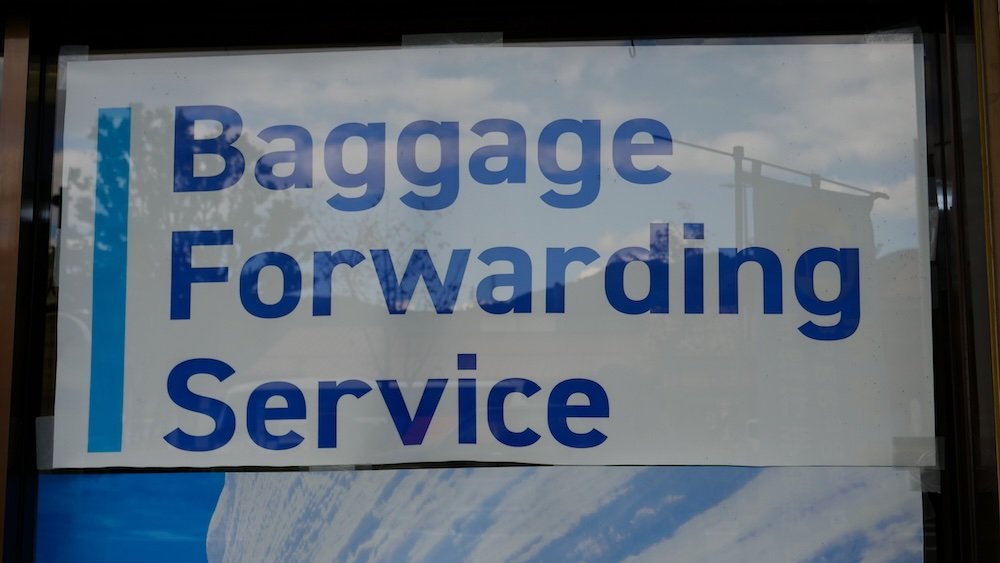
Baggage Forwarding Service
How It Works & Where to Drop Off Luggage
One of the Alpine Route’s greatest conveniences is the baggage forwarding service. Instead of lugging a heavy suitcase through cable cars and tunnels, you can send it ahead and travel light.
- Drop-Off: At your starting point (such as Dentetsu Toyama Station), you’ll find a baggage counter. Hand over your bags, fill out a simple form, pay a fee, and you’re good to go.
- Time-Saving Convenience: This is a godsend if you’ve been shopping in the city or hauling camera gear. Arrive at each station unencumbered and ready to explore.
Picking Up Luggage at the End of the Route
You’ll be reunited with your bags at your designated end point, often Shinano-Omachi or another nearby station. Just show your receipt, and you’ll get your luggage back safe and sound. This means you can wrap up your Alpine adventure and roll straight onto your next destination without backtracking.
Tip: Make sure to note the cut-off times for baggage drop-off and pick-up. Missing these windows could leave you stranded or force you to carry bags during the entire route.
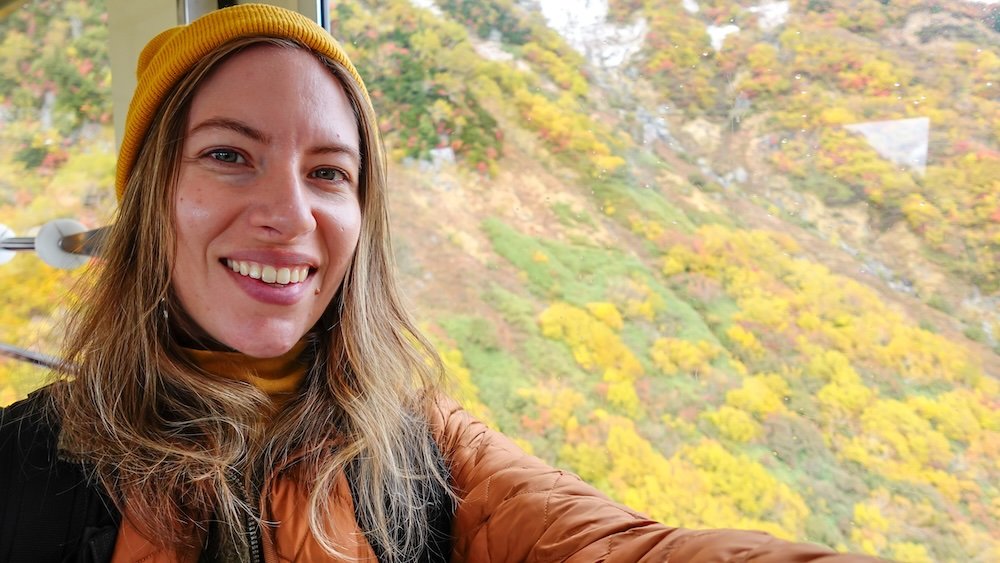
Detailed Step-by-Step Journey Across the Alpine Route
Below, we’ll guide you through each leg of the journey, sharing not only the practical details but also the sensory encounters you can expect along the way. Keep in mind that what we describe here is just the framework; the real magic lies in the subtle play of light across a valley, the distant roar of a waterfall, or the sudden hush when you enter a high-mountain tunnel.
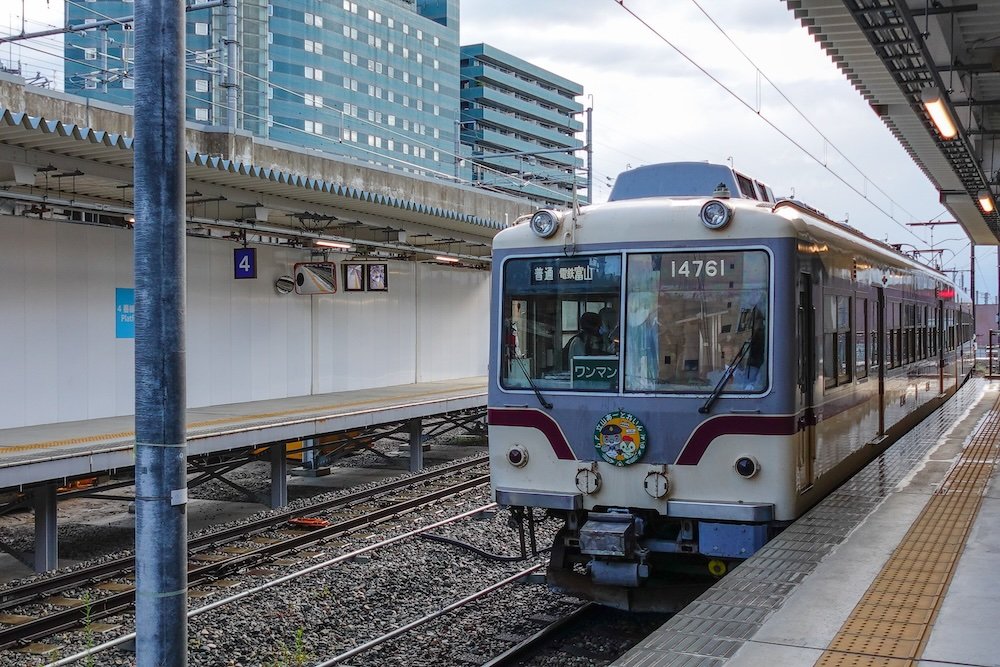
Toyama Chitetsu Railroad (65 minutes)
Departing from Dentetsu-Toyama Station
Your adventure begins at Dentetsu-Toyama Station, a bustling yet manageable hub where you’ll likely have purchased your Alpine Route ticket. There’s excitement in the air and perhaps a tinge of nervous energy—this is, after all, the start of a full-day odyssey across some of the most impressive landscapes Japan has to offer.
Leaving the Urban Scenery Behind
As the Toyama Chitetsu Railroad chugs out of the city, you’ll watch the urban streets and concrete structures recede behind you. Sit by the window if you can. Within minutes, modern buildings give way to suburban outskirts, and then to patchworks of farmland. The slow transition is calming. Rice paddies shimmer in the sunlight, small houses sit snugly beside country lanes, and the first green foothills appear in the distance. It’s a gentle introduction, a visual prologue before the main event begins.
Scenic Views En Route to Tateyama Station
The ride takes about 65 minutes, so settle in and let your mind wander. You might see locals heading home with grocery bags, students making their way to class, or travelers like yourself craning their necks to catch a glimpse of mountain silhouettes. Keep your camera handy. As you near Tateyama Station, the hills grow steeper, and the sense of anticipation heightens. Soon, you’ll leave level ground behind and begin your upward quest.
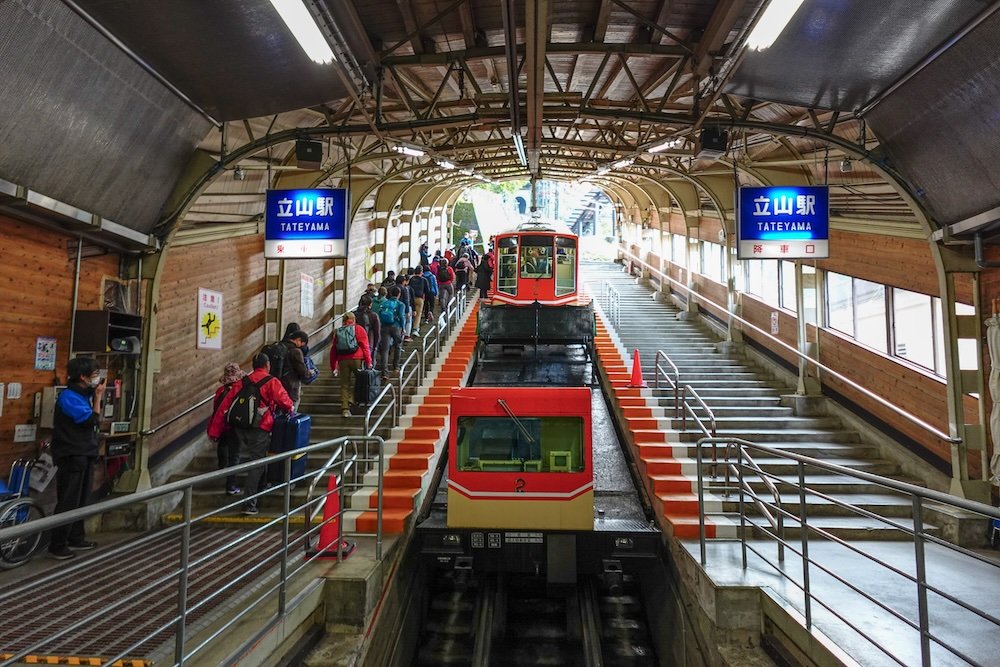
Tateyama Cable Car (7 minutes)
Journey from Tateyama Station to Bijodaira
Exiting the train at Tateyama Station, you’ll feel an immediate shift. The air is crisper, fresher, and carries a subtle scent of forest and earth. To continue your ascent, hop on the Tateyama Cable Car. This brief but exhilarating 7-minute ride pulls you swiftly uphill. It’s a straight line to higher elevation, and you can almost feel gravity playing its part as you rise.
Climbing 502 Meters in Just 1.3 km
In a matter of minutes, you’ll cover a vertical distance that would take hours on foot. The cable car is snug, and as it glides upward, you’ll notice the track cutting through dense foliage. Leaves might brush past the windows, and if you’re traveling in autumn, you’ll be passing through tunnels of gold and crimson.
Transition from Town to Mountain Foothills
At Bijodaira, you step out into a whole new environment. You’ve left behind the hum of Toyama’s streets and arrived at a gateway to the highlands. This area is lush with trees and ferns, and if you listen carefully, you might hear the call of birds or the whisper of a distant stream. It’s a gentle appetizer for what’s yet to come—nature here is vibrant, and it’s only going to get wilder and more dramatic as you continue.
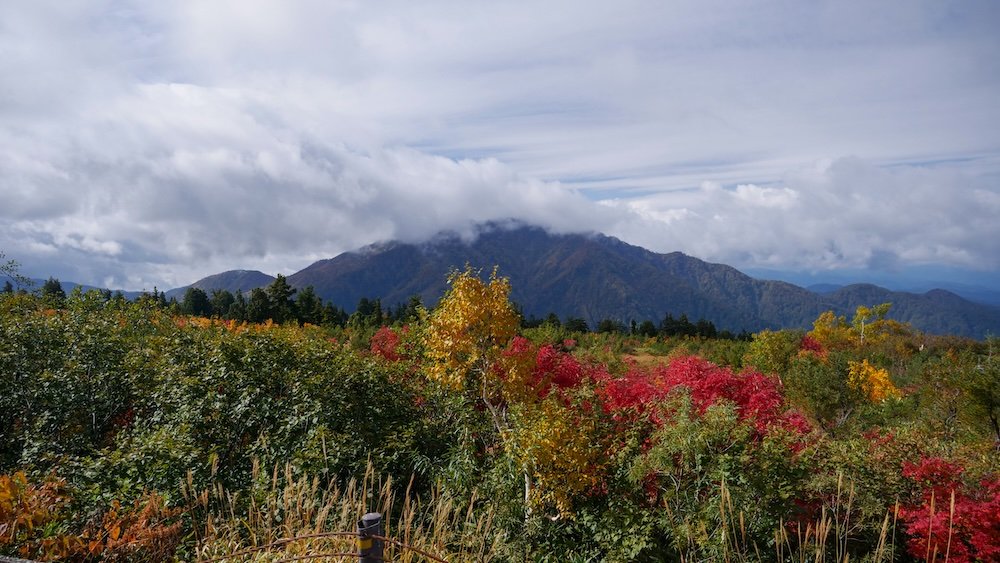
Tateyama Highland Bus (50 minutes)
Traveling from Bijodaira to Murodo
Now it’s time to board the Tateyama Highland Bus, which escorts you from Bijodaira to Murodo in about 50 minutes. This is no ordinary bus ride—it’s an evolving panorama that packs three distinct seasons into less than an hour. Buckle up, get cozy, and pay attention, because the world outside your window is about to change drastically.
Experiencing Three Seasons in One Route
This segment is famous for offering a kaleidoscopic journey through nature’s color palette.
- Green Fields: Initially, the landscape is all about lush greenery and dense forests. Think tall cedar trees and moss-covered stones.
- Colorful Foliage: As you ascend, autumn takes center stage. The foliage blazes red, orange, and yellow, like an artist’s palette spilled across the hillsides.
- Snowy Peaks: Nearing Murodo, you might spot patches of lingering snow clinging to rocky slopes. In cooler months, entire ridges might be draped in white, a stark and beautiful contrast to the earlier greens and reds.
Dramatic Altitude Change of Nearly 1,500 Meters
Over the course of this single bus journey, you’ll gain an immense amount of elevation. Your ears might pop, and your body will sense the cooler, thinner air. The switchbacks on the road zigzag up the mountain, offering thrilling glimpses of valleys below and peaks above.
Winding Mountain Roads and Breathtaking Vistas
The driver maneuvers expertly along narrow roads that hug steep slopes. At each bend, a new postcard-worthy view emerges—distant peaks shrouded in mist, waterfalls tumbling over rocky outcrops, and the subtle line between forested ridges and open alpine meadows. Keep your camera ready, but also remember to just enjoy the ride—some views are best savored rather than captured.
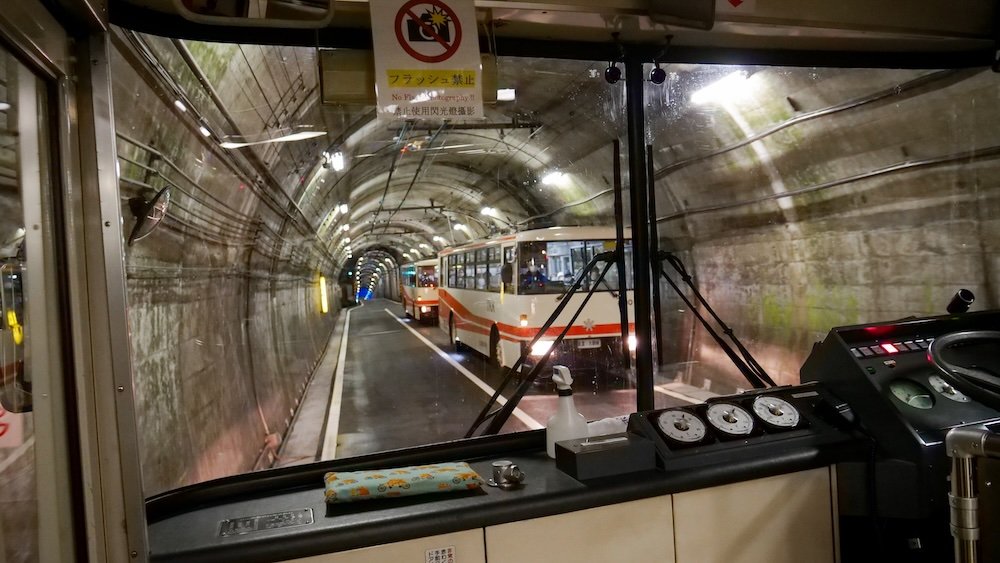
Tateyama Tunnel Trolley Bus (10 minutes)
Crossing Mount Tateyama Through a Narrow Tunnel
At Murodo, you’ll switch to the Tateyama Tunnel Trolley Bus. This step takes you through a tunnel carved right into Mount Tateyama itself. There’s a sense of moving through the mountain rather than over it, and it’s an intriguing, slightly otherworldly feeling.
Eco-Friendly, Electric-Powered Transportation
This bus is not your average city commuter—it’s electric-powered, reducing environmental impact and preserving the pristine alpine environment. Inside the tunnel, it’s quiet, save for the hum of the vehicle. Outside, thick stone walls and dim lights create a surreal passageway.
Covering 3.7 km with a 134-Meter Gain in Elevation
The 10-minute ride might be short, but it continues the upward trajectory. You emerge onto the other side of the mountain, feeling almost like you’ve discovered a hidden world. The gentle elevation gain here sets you up for the next thrilling segment: the ropeway that glides through the skies.
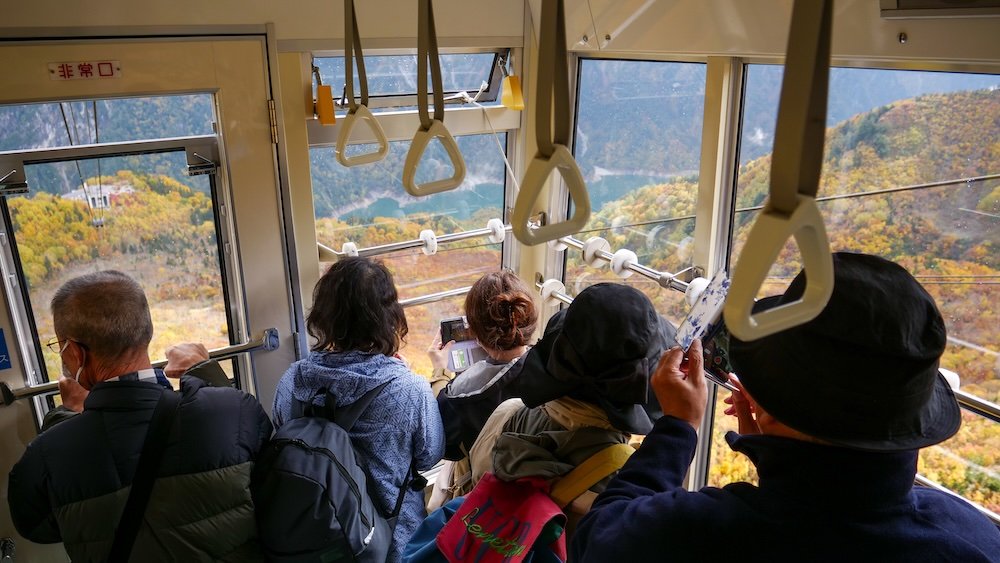
Tateyama Ropeway (7 minutes)
Daikanbo to Kurobedaira Without a Single Support Pylon
The Tateyama Ropeway is a marvel. Picture this: you board a cable car that travels 1,700 meters without a single support pylon propping it up along the way. Instead, you’re suspended in mid-air between two stations, gliding like a bird over rugged terrain.
A Unique Engineering Marvel in Japan
This is not just a ride; it’s an achievement in engineering. The ropeway’s design allows for panoramic views uninterrupted by tall towers. As you soar above alpine meadows and rocky crags, you’ll realize that the absence of pylons also creates an unbroken, cinematic view beneath your feet.
Panoramic Views of Alpine Peaks and Valleys
For 7 minutes, you can do little else but stare in awe. The mountain scenery here is spectacular. In autumn, imagine a patchwork quilt of foliage spread out below, with jagged peaks framing the horizon. Clouds may drift past, momentarily enveloping you in mist. As you approach Kurobedaira, the anticipation builds. Another segment completed, another magical vista etched into your memory.
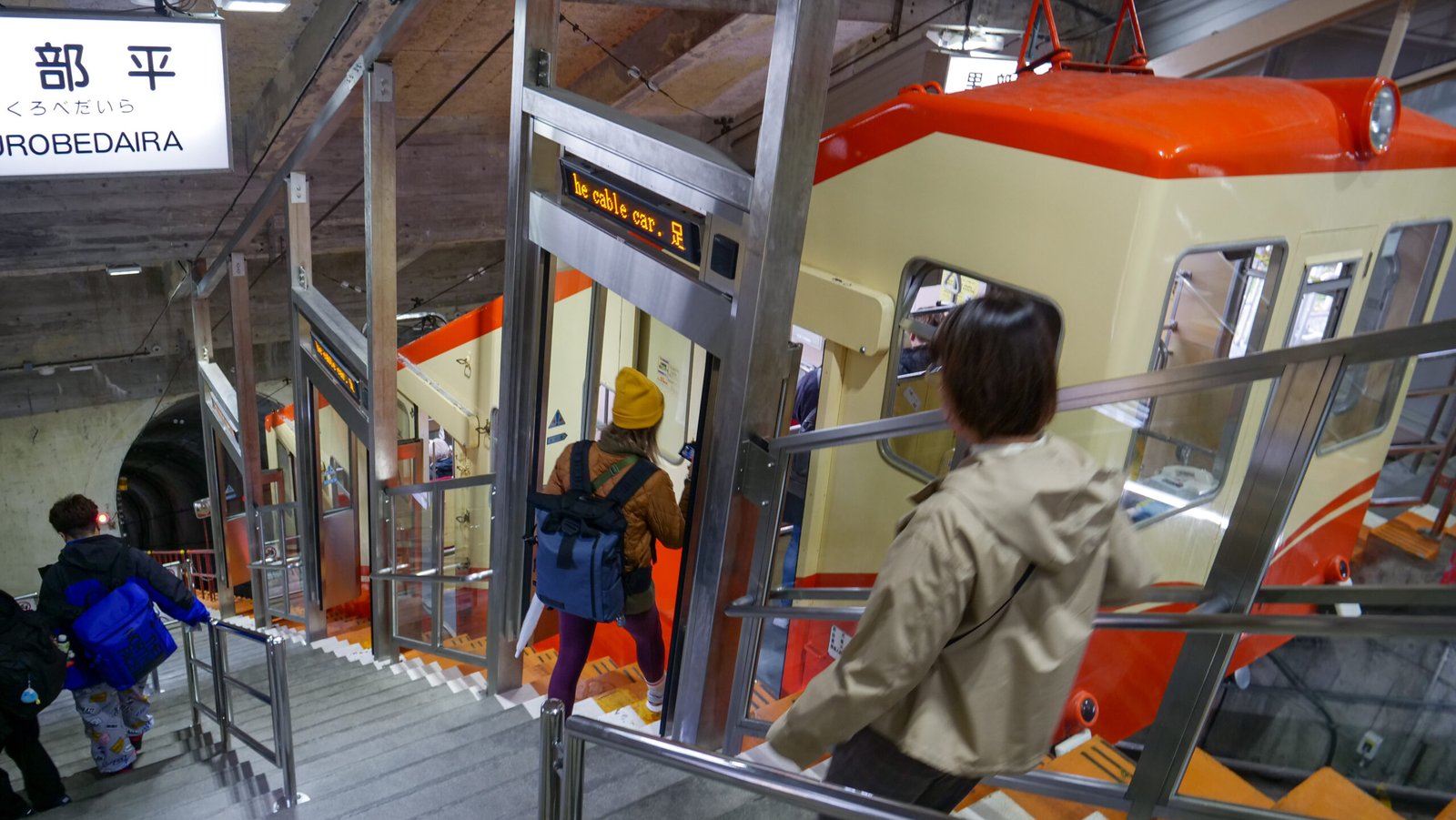
Kurobe Cable Car (5 minutes)
Underground Travel from Kurobedaira to Kurobeko
Now for something completely different: the Kurobe Cable Car. This short 5-minute ride takes you underground. That’s right—you’ll be descending through the mountain’s interior, protected from the harsh winter snows and weather conditions that batter this region.
Protected from Heavy Snowfall
Because it’s entirely enclosed, the Kurobe Cable Car operates smoothly, regardless of the elements. While summer might bring greenery and warmth, and autumn layers of color, winter in these mountains can be fierce. Deep snowdrifts and bitter winds challenge engineers to design transportation that works in all conditions, and this cable car is a prime example of such ingenuity.
Short but Steep Journey (0.8 km, 373-Meter Elevation Change)
It’s over almost before it begins, but don’t underestimate this stretch. Dropping 373 meters in less than a kilometer is no small feat. One moment you’re at Kurobedaira, and the next you arrive at Kurobeko, feeling like you’ve traveled through secret passages of the earth.
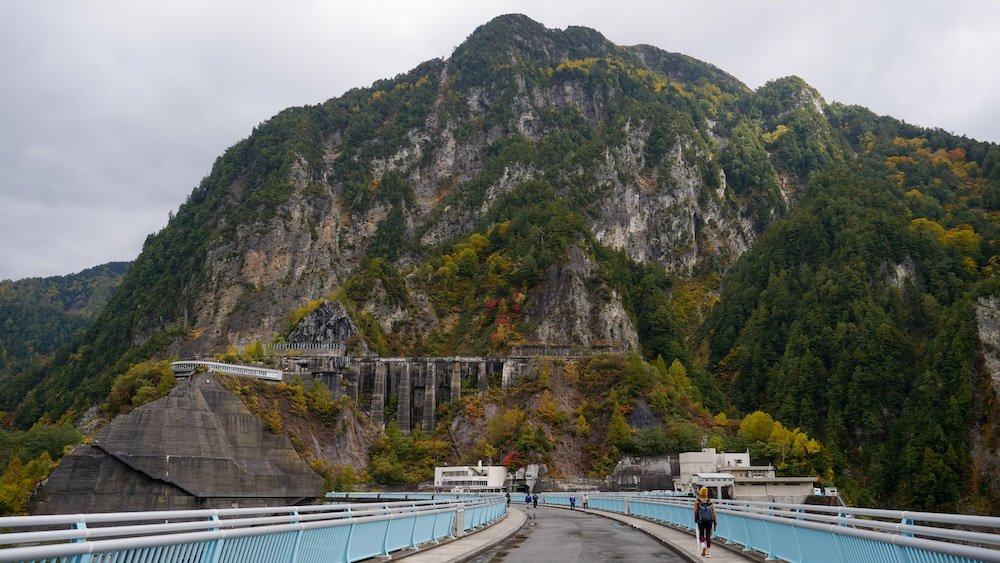
Crossing the Kurobe Dam on Foot (15 minutes)
Tallest Dam in Japan (186 Meters)
Emerging at Kurobeko, you now have the chance to experience a different mode of travel: your own two feet. The Kurobe Dam is a sight to behold—towering at 186 meters, it’s Japan’s tallest dam, and it was constructed with sheer grit between 1956 and 1963. Walking across it, you’ll feel both humbled by its scale and inspired by the engineers who made it possible.
Historical Context: Built Between 1956-1963
The dam stands as a testament to Japan’s post-war resilience, an icon of progress during a transformative era. Understanding its history adds depth to your journey. This isn’t just a pretty place—it’s a monument to human determination, cooperation, and ingenuity.
Optional Sightseeing Boat Ride on Kurobe Lake
If time allows, consider hopping on a sightseeing boat that cruises Kurobe Lake. The perspective from the water is different, allowing you to look up at the dam’s massive walls and the surrounding peaks. If you’re tight on schedule or want to reach Nagano by dusk, it’s okay to skip this option. Just remember it’s there if you want to savor more time in the region.
Enjoying Panoramic Lake and Mountain Views
Stroll across the dam’s walkway, pause at viewing platforms, and listen to the rush of water. Feel the mist on your face if the spillways are open. Up here, nature and human creation coexist. It’s a quiet reminder that while we can shape our environment, we must also respect its immense power.
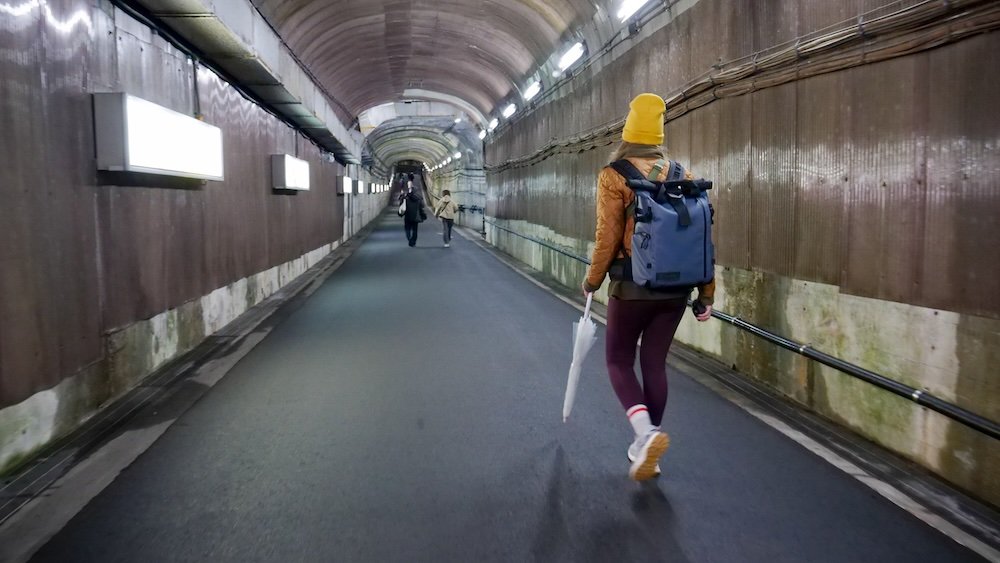
Kanden Tunnel Electric Bus (16 minutes)
Traveling from Kurobe Dam to Ogizawa Station
Next up is the Kanden Tunnel Electric Bus, another feat of eco-friendly engineering. It whisks you from the dam area through the mountain to Ogizawa Station. Like the Tateyama Tunnel Trolley Bus, this ride takes you through the inner workings of the mountain’s bedrock, linking two key points of the route.
6.1 km Journey Inside the Mountain
For 16 minutes, you’re in a subterranean world. The tunnel itself, 6.1 kilometers long, might feel like a secret passage connecting hidden realms. Without the occasional passing light and the quiet hum of the bus, you might forget where you are. But trust the route—this is a streamlined, strategic link, ensuring you remain sheltered from any extreme weather outside.
Gentle 37-Meter Elevation Change
Compared to the dramatic climbs and descents you’ve experienced, this leg is relatively gentle—only a 37-meter elevation difference. It’s a calm, introspective moment near the tail end of your journey, giving you time to reflect on how far you’ve come and what you’ve seen. When you emerge at Ogizawa Station, you’ll be ready to complete the final stretch.
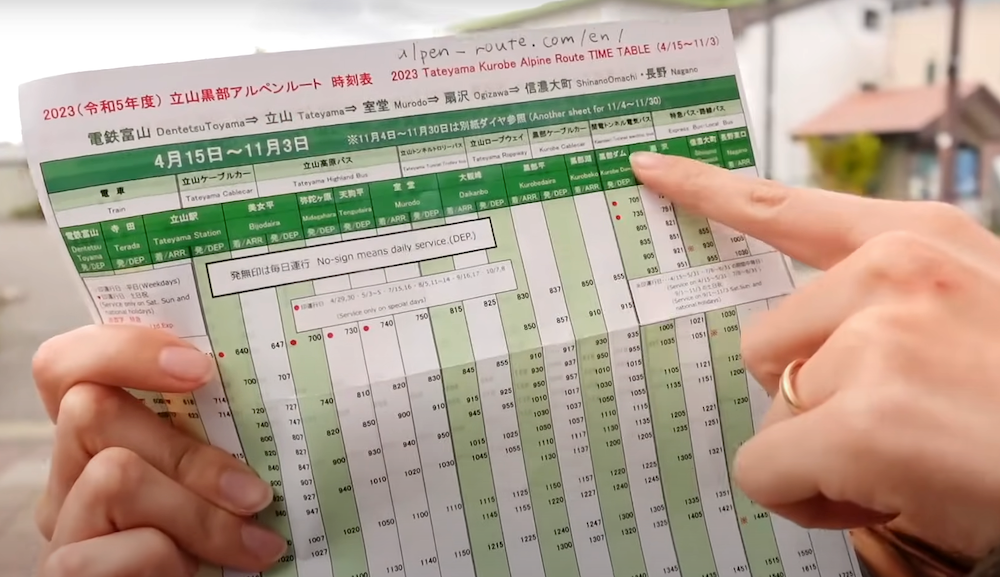
Local Bus to Shinano (40 minutes) and Onward to Nagano
Arriving at Shinano to Retrieve Forwarded Luggage
From Ogizawa, it’s time to hop on a local bus that will take you to the Shinano area. This 40-minute ride feels almost like a wind-down: you’re descending back towards more populated regions, and the landscapes soften as you approach lower elevations. If you’ve taken advantage of the baggage forwarding service, this is where you’ll be reunited with your luggage—no more heavy backpacks or rolling suitcases to worry about along the high-elevation segments.
Direct Bus Alternatives for Travelers Without Baggage Pick-Up Needs
If you haven’t forwarded your luggage and want to save some time, you might consider direct buses heading straight to Nagano. These services are designed for travelers who are eager to move on to their next destination without any detours. Planning in advance can help you decide which option suits your schedule best.
Continuing Your Journey to Nagano City
Finally, you’ll head towards Nagano City, a transport hub known for its rich history (Zenko-ji Temple is a must-see) and its role as a gateway to other parts of Japan. After a day spent soaring through alpine heights and tunneling through mountains, the return to a bustling city can feel surreal. As you arrive, you might be tired, but it’s the satisfying kind of tired that comes from adventure and discovery.
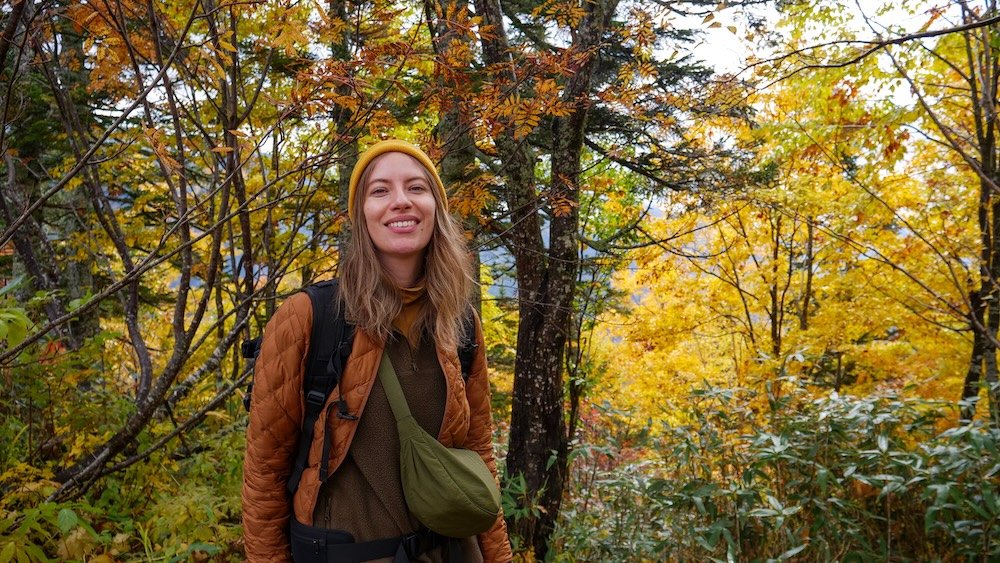
Tips for a Smooth Journey
Whether you’re tackling this epic route in a single day or taking your time to savor each vantage point, these practical tips will help streamline your adventure. From layering your clothes to planning your breaks, think of this as your personal checklist to ensure everything goes off without a hitch.
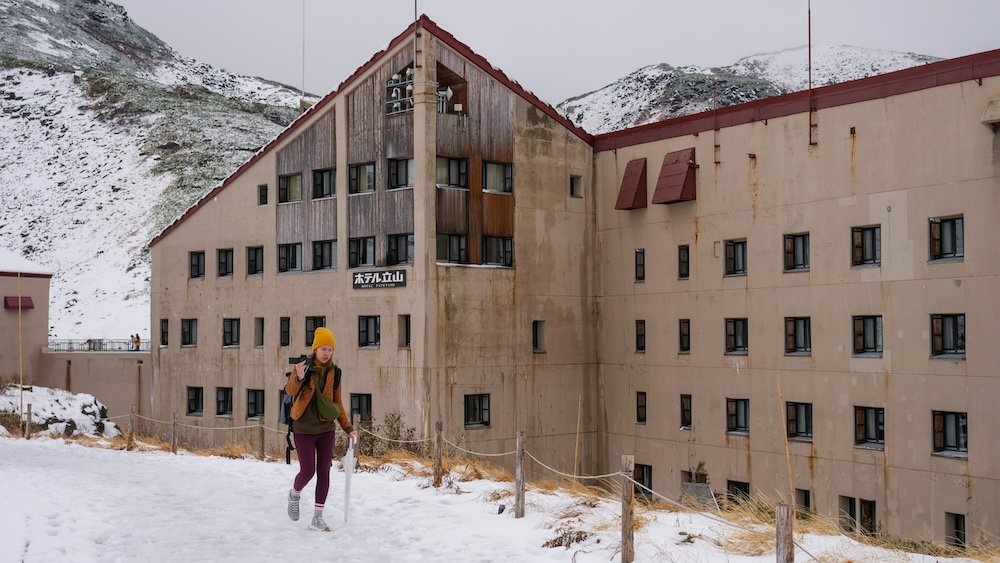
Dress in Layers
The Alpine Route weaves through dramatically shifting elevations, which means temperatures can swing from pleasantly warm to bitingly cold in a matter of hours. Don’t leave your comfort to chance.
Start with Warm Clothes & Prepare for Sudden Temperature Shifts
You might begin your journey in mild weather, but as you ascend, the air gets thinner and chillier. Keep it simple but effective:
- Base Layer: A breathable, moisture-wicking shirt.
- Mid Layer: A fleece or lightweight down jacket for insulation.
- Outer Layer: A shell jacket that’s water-resistant and windproof.
Rainproof and Windproof Outerwear Recommended
Mountaintop weather can be unpredictable. One moment the sun is shining, and the next, clouds could roll in bringing gusty winds or even a sudden shower. Pack a waterproof, windproof jacket and consider lightweight, packable rain pants. These don’t take up much space, but trust me, when the weather turns, you’ll be grateful you have them.
Tip: Gloves, a scarf, and a beanie might seem like overkill, but they’re incredibly useful once you’re higher up, especially in the late afternoon when temps begin to drop.
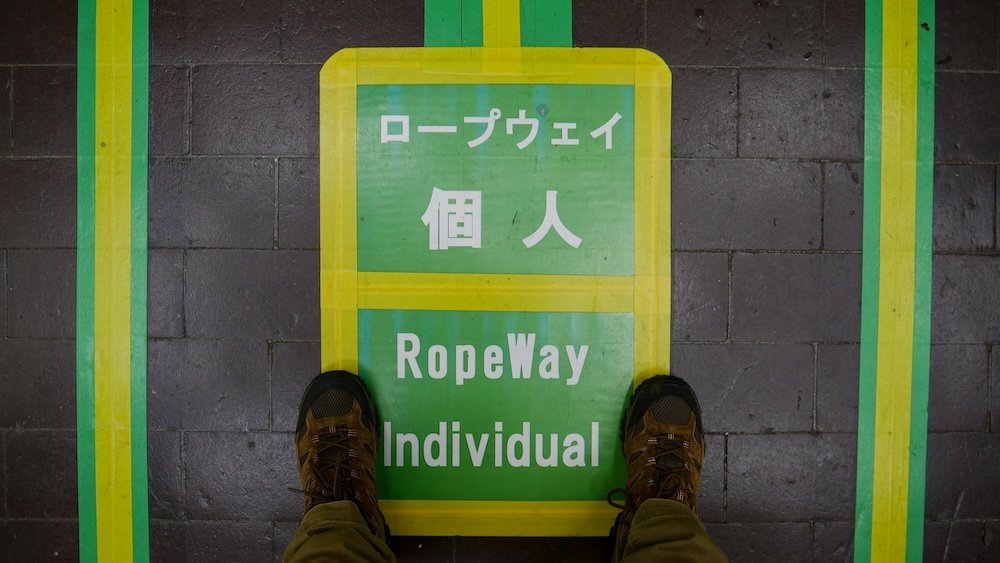
Pace Yourself
You’re not running a marathon here; you’re immersing yourself in one of Japan’s most breathtaking landscapes. Rushing from point A to point B defeats the purpose. The journey is the experience, so give yourself permission to slow down.
Allot Extra Time for Photo Stops
This route is a photographer’s dream. You’ll want to linger at viewing platforms, snap that perfect panorama, and capture the way the sunlight filters through the autumn leaves. Add a little buffer time into your schedule to avoid feeling rushed. Trust me, it’s worth it.
Consider Breaks for Meals or Snacks En Route
You might not encounter gourmet restaurants at every stop, but you’ll find cozy eateries and small snack counters. Taking a break isn’t just about refueling your body; it’s about letting the scenery sink in. Bring a few energy bars and a water bottle, but also treat yourself to local bites along the way. A warm bowl of noodles or a cup of hot tea can be a welcome treat after a chilly cable car ride.
Tip: If you’re traveling during peak season, lines can form, so having some snacks on hand keeps “hangry” moods at bay if you have to wait.
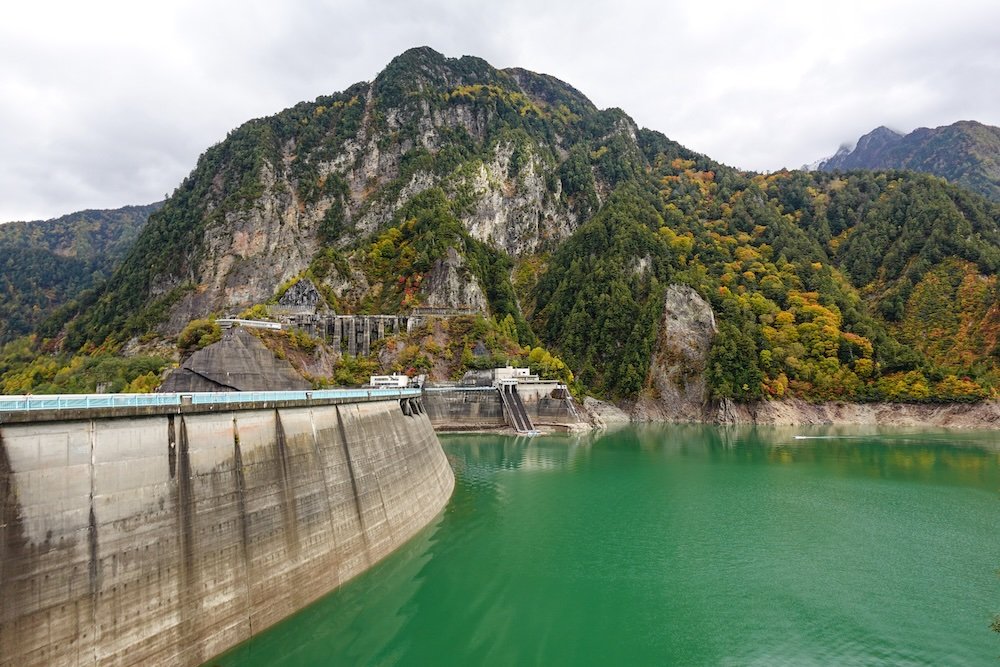
Follow Seasonal Schedules
One of the keys to a smooth adventure is knowing the rhythm of the route. Different seasons bring different operating hours, crowd levels, and even temporary closures due to weather conditions.
Check Transport Timetables in Advance
Each transportation segment has its own schedule. Missing a bus or a cable car connection could mean waiting longer than you’d like. Before setting out, hop online or check a printed timetable. Better yet, ask at the station’s information desk—staff are usually incredibly helpful and often speak enough English to point you in the right direction.
Be Aware of Seasonal Closures or Weather Disruptions
Some parts of the route may close earlier in autumn, or certain lifts might pause if the weather’s too rough. Keep an eye on official websites or ask local tourism offices for updates. Conditions can change overnight, and you don’t want to be caught off-guard halfway up a mountain.
Tip: Early birds often avoid the largest crowds. Starting earlier can mean shorter lines, especially at popular spots like Murodo or Kurobe Dam.
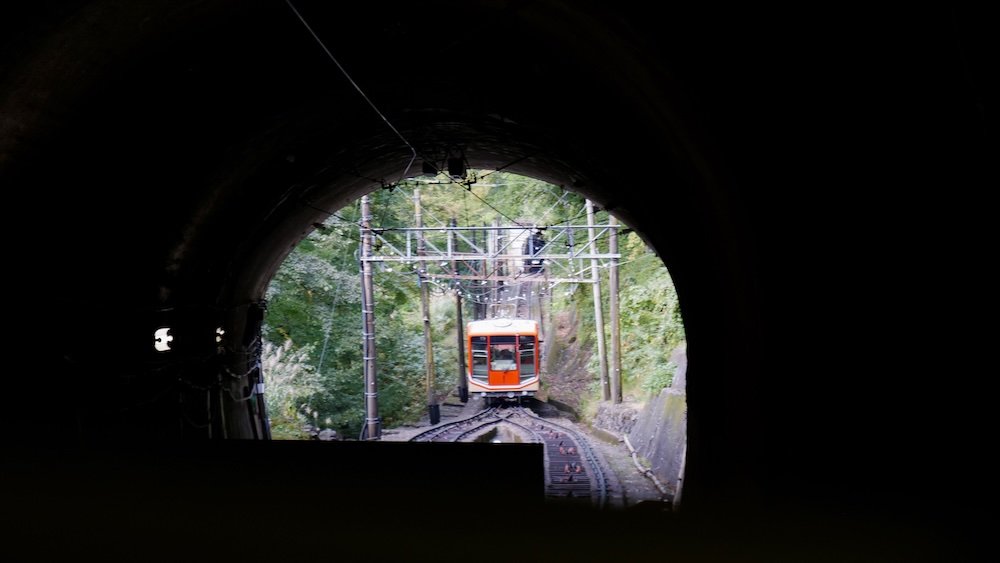
Make Use of Forwarding Services
Remember those big suitcases you dragged through the city? You don’t want to haul them up and down cable car stations and through narrow tunnels. This is where the baggage forwarding service comes in like a superhero.
Travel Light Between Stations
By forwarding your luggage, you free yourself from unnecessary weight. This means you can skip the sweaty ordeal of schlepping heavy bags along winding walkways and steep inclines. Imagine strolling across the Kurobe Dam unencumbered, camera in hand, instead of struggling with suitcases on every stair.
Ensure You Know Where and When to Pick Up Your Luggage
Forwarding services have specific drop-off and pick-up points, as well as cut-off times. Double-check these details before you start. When you reach your final destination—often Shinano or another key station—your bags will be waiting, allowing you to continue your journey to Nagano or beyond without backtracking.
Tip: Keep the forwarding service receipt in a safe place. Without it, you might face delays when claiming your luggage.

Conclusion
Reflecting on the Alpine Adventure
Crossing the Tateyama Kurobe Alpine Route is like unwrapping a series of nature’s beautifully layered gifts, each one a surprise waiting to astonish you. In a single day, you travel through a kaleidoscope of environments—lush forests, fiery autumn foliage, snowy peaks—an entire year’s worth of seasonal change packed into just a few hours. You hop between trains, cable cars, buses, ropeways, and even walk across a towering dam, each transition offering a fresh perspective on Japan’s rugged alpine world.
Marvel at the Variety of Landscapes in a Single Day
It’s hard to believe how many different ecosystems you can pass through so quickly. One moment, you’re gliding above dense evergreens and bright red leaves, the next you’re perched among rocky outcrops dusted with early snow. The route turns your journey into a living slideshow, and every click of the camera shutter captures a new painting crafted by nature’s hand.
Appreciate the Engineering Feats that Make the Journey Possible
But it’s not just natural wonders that deserve your admiration. The intricate network of tunnels, cable cars, and dams is a testament to human ingenuity. Without these monumental engineering achievements—the Tateyama Tunnel Trolley Bus, the Kurobe Dam, and the underground cable car—you’d never experience these remote heights with such ease. This route proves that when humans work with nature rather than against it, the results can be awe-inspiring.
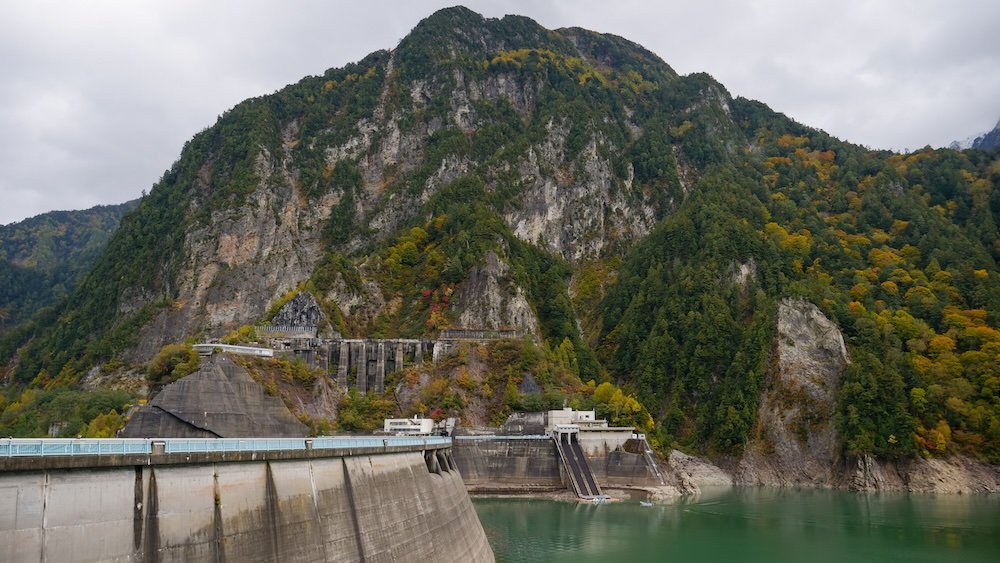
Inspiring Future Travelers
Encouraging Visitors to Discover Japan’s Alpine Charms
If you’ve read this far, it’s probably because the idea of traversing the Japanese Alps has piqued your curiosity. The Tateyama Kurobe Alpine Route isn’t just a checklist item for hardcore mountaineers; it’s accessible to a wide range of travelers. You don’t have to be a seasoned adventurer to enjoy it. With convenient transport links, well-maintained paths, and clear signage, this is a high-altitude escape that welcomes everyone.
Emphasizing the Uniqueness of the Alpine Route Experience
While Japan is famous for its cherry blossoms, sushi, and vibrant cities, fewer travelers delve into the country’s alpine treasures. This route sets itself apart with its ability to cram so much variety into one cohesive experience. It’s simultaneously a lesson in natural diversity and a celebration of modern engineering, tied together by a sense of quiet reverence for the mountains. If you’re looking for something beyond the usual tourist hotspots, this journey delivers.

Final Thoughts and Additional Resources
As you plan your adventure, remember to check official sources for the latest information. Seasonal closures, weather forecasts, and timetable adjustments are all factors that can influence your trip’s success. Taking a moment to prepare—dressing in layers, pacing yourself, and utilizing luggage forwarding services—helps you enjoy every minute of this alpine odyssey.
Suggestions for Nearby Attractions and Onward Travel in Toyama and Nagano
Don’t rush off too quickly once you’ve crossed the Alps. The surrounding regions have plenty to offer:
- In Toyama:
- Toyama Castle: Learn about the area’s feudal history.
- Fresh Seafood at Toyama Bay: Savor local delicacies and recharge after your adventure.
- In Nagano:
- Zenko-ji Temple: A spiritual gem and a must-see cultural stop.
- Snow Monkey Park (Jigokudani): If you’re traveling in winter, watching monkeys soak in hot springs is surreal and heartwarming.
